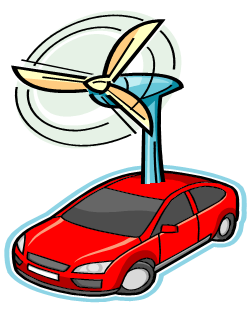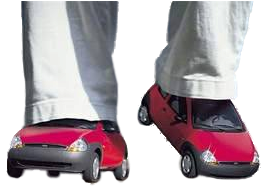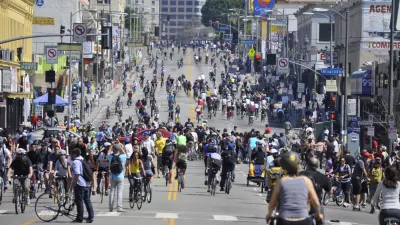Technology innovation – that’s all we need to solve the energy crisis! Unleash American ingenuity and we’ll be able to cope with higher energy costs. The Windmillmobile, should go a long way toward reducing petroleum consumption. It seems to work fine unless there is a strong tailwind. The engineers are still working on the sensor to fold down the windmill for garages and overpasses.
Technology innovation – that's all we need to solve the energy crisis! Unleash American ingenuity and we'll be able to cope with higher energy costs. The Windmillmobile, should go a long way toward reducing petroleum consumption. It seems to work fine unless there is a strong tailwind. The engineers are still working on the sensor to fold down the windmill for garages and overpasses.
It has been rather stunning lately to listen to the prognostications about how we should adapt transportation to respond to higher energy costs. It seems like some folks have left their common sense at home and lost their calculators. One media query suggests that air travelers stung by higher fares due to energy costs should switch to rail. But the passenger miles traveled on airlines is 1,000 times the passenger miles traveled on intercity rail. So if one in a hundred air travelers switched it would produce nearly a ten fold increase in Amtrak ridership. Quite a crowd trying to use the 50 percent of Amtrak's seats that are unoccupied or crowd on what modest additional capacity Amtrak could produce in the short term.

Numerous popular media stories have covered the "surge" in transit ridership (transit ridership up 3.3% the first quarter of 2008) some implying it is absorbing the decline in vehicle miles traveled (down 2.3% in the first quarter of 2008). Putting a calculator to work reveals that the transit ridership increase could only explain 1-2% of the decline in VMT.
Perhaps my favorite is in the statement in the National Surface Transportation Policy and Revenue Study Commission January 2008 Report to Congress titled Transportation for Tomorrow, which advocated an investment strategy for intercity rail noting:
Intercity passenger rail investment would help meet important national energy and environmental goals by shifting travel to trains, which consume approximately 17 percent less energy per passenger mile than air carriers and 21 percent less energy per passenger mile than automobiles.
So we should spend decades and billions for intercity rail when the recently passed new Corporate Average Fuel Efficiency (CAFE) standards will deliver an approximately 40% improvement in vehicle efficiencies perhaps well before there could be a meaningful degree of implementation of intercity rail? Won't the next generation of aircraft better historic airline fuel efficiencies more than enough to reverse the rail-air comparative advantage as well?
As we think about the future we need to keep several things in mind.
1. Historic modal efficiencies are not particularly important. Future investment decisions should be based on expected future modal efficiencies.
2. Future modal efficiencies are affected by several factors. The massive market for personal vehicles provides motivations for dramatic investment for change in this mode. The life cycle of autos is shorter enabling new technologies to get in service faster. On the other hand, fleet modes such as busses have centralized operating facilities that might be better able to accommodate new fueling technologies.
3. Efficiencies can by attained by fundamental improvement in propulsion efficiencies as well as by resizing/scaling the technology to more closely match the market demands. Autos will be incorporating new propulsion technologies and will be downsized/lighter to help improve efficiencies. Aircraft will also be lighter through use of new materials as well as incorporating propulsion efficiencies. Rail has historically been dependent on high mass vehicles to provide traction and crush safety. It remains less clear how quickly transit and rail technologies might be able to adapt vehicle size and weight to closely match market needs and complement propulsion technology changes.
4. Technologies with longer life capital elements or systems elements that deter incremental change could fair more poorly in the march to energy efficiencies. Autos and buses have relatively short life cycles, modest capital costs and have autonomous vehicles independent from the guideway; thus, they can enable relatively rapid integration of state of the art technologies. Longer-lived vehicles such as planes and trains are less able to have new technologies produce near term impacts on overall modal efficiencies. Modes where the vehicle and guideways are integrated systems may be far more difficult or expensive to upgrade to newer more efficient technologies.
5. Fair evaluations of efficiencies need to include the full door-to-door trip and both operating and supportive infrastructure energy use. This includes the role of feeder modes, the energy use for infrastructure construction and the circuitousness of travel inherent in the nature of the mode.
6. Indirect energy impacts of modes need to be considered as well. Urban rail advocates cite the ability of urban guideway investments to influence land use in such a way that the overall energy savings benefit goes beyond the relative modal efficiencies. The argument being that rail can induce persons to live in locations where they have shorter trips, more walking, and transit trips, thus reducing overall energy use. To the extent that this impact can be validated and leveraged to new markets it merits inclusion in modal efficiency evaluations.
7. Future efficiencies of travel modes will be very dependent on how well consumers accept and how intensively they use new modal capacity. The utilization of each mode is highly relevant to the overall efficiency calculations of future investments. Average auto occupancy now is 1.6 meaning that 2-3 seats are vacant and can accommodate additional passengers or the vehicle can be downsized. Urban buses average about 11 passengers per vehicle in vehicles that can accommodate 40 or more passengers. Airlines operate at over 80 percent occupancy and Amtrak operates approximately half full. Different modes have different degrees of attractiveness and different attainable occupancies. Autos never have empty reverse commute trips or deadhead mileage back to the garage. Multi-stop scheduled modes such as the many bus and rail services with off-peak and off-direction travel cannot be expected to have as high of occupancies as point-to-point modes.
8. Planners and policy makers need to consider the extent to which energy costs are likely to influence the demand profile of the modes. Will higher fuel prices attract enough riders to increase productivity of existing operations or will service expansion to meet peak demand or appear politically responsive to high fuel costs result in lower overall operating efficiencies.
9. Visions of radical transformation of our transportation infrastructure are likely to come up against severe cost and capacity constraints. If every urban area that is proposing new transportation systems were to move ahead we would have a shortage of professional expertise, and critical components. How fast, for example, could the rail car industry be scaled up to meet this need?
10. Finally, we need to be careful in determining how the public resolve responds to planners' visions of future travel options. The increase in energy costs is and will continue to change behaviors but we need to use caution in estimating how quickly travelers will trade off time and convenience for energy cost savings.
You never know what the future will bring. If we are not careful we could do some things that would make corn ethanol look like a wise investment. 
First published in the Urban Transportation Monitor, Volume 22, No. 13., July 11, 2008.

Planetizen Federal Action Tracker
A weekly monitor of how Trump’s orders and actions are impacting planners and planning in America.

Chicago’s Ghost Rails
Just beneath the surface of the modern city lie the remnants of its expansive early 20th-century streetcar system.

San Antonio and Austin are Fusing Into one Massive Megaregion
The region spanning the two central Texas cities is growing fast, posing challenges for local infrastructure and water supplies.

Since Zion's Shuttles Went Electric “The Smog is Gone”
Visitors to Zion National Park can enjoy the canyon via the nation’s first fully electric park shuttle system.

Trump Distributing DOT Safety Funds at 1/10 Rate of Biden
Funds for Safe Streets and other transportation safety and equity programs are being held up by administrative reviews and conflicts with the Trump administration’s priorities.

German Cities Subsidize Taxis for Women Amid Wave of Violence
Free or low-cost taxi rides can help women navigate cities more safely, but critics say the programs don't address the root causes of violence against women.
Urban Design for Planners 1: Software Tools
This six-course series explores essential urban design concepts using open source software and equips planners with the tools they need to participate fully in the urban design process.
Planning for Universal Design
Learn the tools for implementing Universal Design in planning regulations.
planning NEXT
Appalachian Highlands Housing Partners
Mpact (founded as Rail~Volution)
City of Camden Redevelopment Agency
City of Astoria
City of Portland
City of Laramie




























